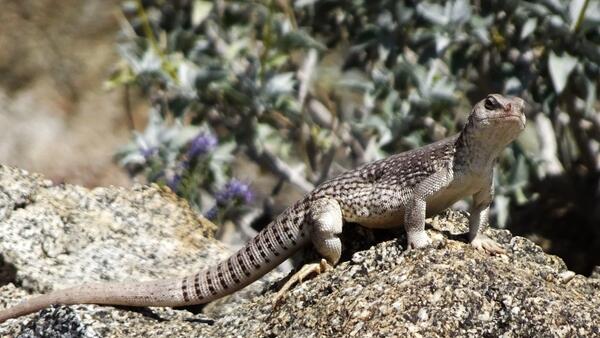The richness and diversity of lizards
"Lizards of every temper, style, and color dwell here, seemingly as happy and companionable as the birds and squirrels." — John Muir
By CAMERON BARROWS
Across the deserts of the Earth, reptiles are more numerous and diverse than any other group of vertebrates. During the day, that richness and diversity is dominated by lizards (snakes usually dominate the night shift). Lizards divide up the deserts’ available resources by occupying different niches. Some are vegetarians (chuckwallas and desert iguanas), some eat ants (horned lizards), some eat small insects (side-blotched lizards and zebra-tails), some eat bigger insects (spiny lizards, whiptails), some eat other, smaller lizards (collared and leopard lizards and sometimes whiptails), and some eat whatever they find, plant or insect (fringe-toed lizards). Some are active foragers, constantly moving in search of prey (whiptails). All the rest of the insect and lizard eaters sit and wait, saving energy by letting their prey come to them. These categories generally describe the lizards’ dietary niches.
Another way of dividing up the deserts’ available resources is by occupying different thermal niches. Different thermal niches define where and at what season and time of day a lizard might be active. Most desert lizards prefer body temperatures similar to ours, around 95-100˚ F (compared to our 98.6˚). By behaviorally moving among microclimates within their habitats, shade to sun, ground to boulders and trees, lizards can maintain mostly constant body temperatures as long as the sun is out. At one end of the thermal niche spectrum are our deserts’ smallest lizards, desert night lizards (genus Xantusia). These seldom seen saurians spend their lives beneath fallen Yucca branches or ensconced deep in rock crevices. They do not bask in the sun and have the lowest preferred body temperature of any desert lizard, just 72° F. If it gets much warmer than that they head deeper into the rock crevice or perhaps into a rodent burrow.
Next larger in size, side-blotched lizards occupy a broader geographic niche than any other North American desert lizard, living in all the North American deserts, from the Great Basin Desert in eastern Washington to the southern tip of Baja California, to central Mexico’s Chihuahuan Desert. In our Colorado Desert they occur from below sea level in the Salton Sink to above 6,000 feet near Idyllwild. That versatility is in large part because they have a relatively cool preferred body temperature of just above 95˚ F. Even when air temperatures are as low as 60˚ F, by basking if the sun side-blotched lizards can quickly raise their body temperature to their preferred levels. That gives them a window of activity during much of the winter and in the early morning during the summer months when they can be relatively free from predation by larger lizards, species which need much warmer temperatures to be active.
At the other end of the thermal niche spectrum are desert iguanas and zebra-tailed lizards. Iguanas like it especially hot, preferring 104-105 ˚F, tolerating body temperatures as high as 108-109˚ F, hotter than any other known vertebrate. Humans with body temperatures that high don’t survive. Those high temperature preferences mean that they are usually not seen until our desert is getting toasty. For iguanas, those hot body temperatures help digest their vegetarian diets, and also limit their risk of predation from birds such as roadrunners that are less tolerant of such heat. Limit their risk, but early rising iguanas do encounter roadrunners lurking in the shadows, providing the roadrunners with the occasional meal. Zebra-tailed lizards prefer body temperatures up to and a bit higher than 102˚ F (up to 108˚ F). They need such high temperatures to generate the speed they use to avoid predation. If you ever hike a trail in the morning and see mostly side-blotched lizards, but on the return hike encounter desert iguanas and/or zebra-tailed lizards, now you know why. Some lizards like it hot, really hot.
As our climate warms differences in the lizards’ thermal niches should play a role in how or if lizards will be able to adapt to these rapidly changing conditions. So far, we have seen side-blotched lizards becoming less abundant at lower elevations while almost every year breaking through what we previously have thought of as high elevation ceilings on the pine-covered slopes of the montane sky islands. We have seen the same sorts of extensions into higher elevations for desert horned lizards, granite spiny lizards, western fence lizards, zebra-tailed lizards, and desert iguanas. If thermal niches are important in predicting a lizards species’ response to warming conditions, we should expect that the hot loving iguanas and zebra-tails should be perfectly happy at lower elevations. As with almost everything in nature, it likely isn’t that simple. While the lizards may be able to tolerate and even thrive at warmer temperatures, it could be that their food, whether it be plants or insects, is less abundant where higher temperatures and drought have their greatest impacts – at lower elevations. Temperatures are important factors, but food availability year after year probably plays a stronger role in determining breeding success, and where breeding success is highest will determine which direction a population will grow or shrink.
Nullius in verba. Go outside, tip your hat to a chuckwalla (and a cactus), think like a mountain, and be safe
